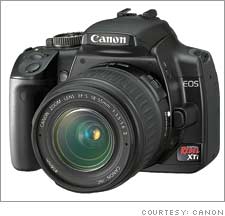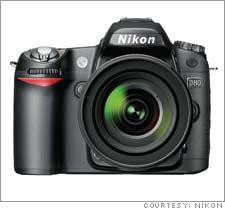|
Shooting for a Perfect 10 A new crop of ten-megapixel digital cameras gives serious amateur shutterbugs a reason to smile. One is the best camera under $1,000, period.
(Fortune Magazine) -- Ah, the memories that a photo album can evoke. Here I am with my first digital camera, the Apple QuickTake 100, along with a serial cable and the Macintosh portable I had lugged up a 12,000-foot mountain, because that was the only way to view the digital snapshots I was taking. See the look on my face? Today I can't tell whether my expression was one of rapture at discovering the joys of filmless photography or oxygen deprivation. The QuickTake had a resolution of about 300,000 pixels and cost $750. Now here I am with the new Canon EOS Digital Rebel XTi digital single-lens reflex (DSLR) camera I carried up the same mountain recently. It has an effective resolution of over ten million pixels and costs $799 (body only), or $899 with a high-quality 18-55mm zoom lens. Pictures can be snapped at three frames per second at full resolution, up to 27 shots in burst mode, and viewed on the camera's exceptionally bright built-in 2.5-inch LCD display.
Now see the look on my face? Definitely rapture. The Canon (Charts) is, quite simply, the best digital camera I've seen for under $1,000. But that's partly because Nikon's new 10.2-megapixel D80, another delightful DSLR camera I've been testing, misses the $1,000 cutoff, unless you count the price of the camera body alone, without a lens. With an 18-135mm zoom lens, The D80 fetches $1,300. And it's also partly because Sony's impressive new ten-megapixel Alpha DSLR-A100K camera, $1,000 including an 18-70mm zoom lens, didn't get to me in time for a review. The arrival of so many high-quality ten-megapixel digital SLR cameras this summer represents a milestone in photo gear. Megapixels are not a reliable measure of a camera's overall quality, because so many other factors - the size of the pixels, the quality of the lens, the color accuracy of the imager, and so on - contribute to the picture that the camera captures. For most users, the salient point is that a ten-megapixel image can be printed at much bigger sizes than, say, a shot taken with a 4MP camera. More practically, a 10MP image gives the photographer more ability to crop a shot, creating a big print from a smaller segment of the overall picture. In general, though, a double-digit megapixel camera is a step closer to that threshold where digital cameras pass 35mm film cameras in quality. Designed for serious amateur photographers but also friendly to the casual point-and-shooter, the Canon Rebel XTi also features a built-in cleaning system that reduces the chance that dust inside the camera will spoil a shot, a bugaboo that plagues most other cameras in its class. No matter how careful one is when changing lenses, dust can enter the camera body to ruin subsequent shots. The XTi literally shakes any dust off the sensor when the camera is turned on or off, using ultrasonic vibrations. The motes are then immobilized on a sticky trap. Also, the camera can "map" stubborn dust particles on the sensor and then erase them from images via software. The Nikon D80, in turn, borrows several features from Nikon's professional-level DSLR cameras, including the image processor from the $4,000 Nikon D2X and the automatic focusing system and 2.5-inch LCD of the upscale D200. One thing the D80 inherits from smaller and cheaper Nikons, however, is an SD (secure digital) memory-card system. Most DSLR cameras today use the larger CF (compact flash) cards, and a ten-megapixel camera demands a high-capacity storage system. (I tested the Canon with Kingston's new eight-gigabyte 133X-speed Ultimate CF card, an excellent performer at $449.) SD cards have smaller capacities than CF (no 8GB SD cards are available today), but the D80 is also compatible with next-generation SDHC cards, which promise to raise capacity to 32 gigabytes someday. Although both the Canon Rebel XTi (usa.canon.com) and the Nikon D80 (nikonusa.com) are superb cameras, I did have two quibbles. The Canon has a plastic body that feels less than rugged. While the D80 has Nikon's typically solid fit and finish, the SD card system is, for now, constraining for a high-quality camera. Even so, both are excellent performers that will fill your photo albums with mountains of happy memories. |
|


